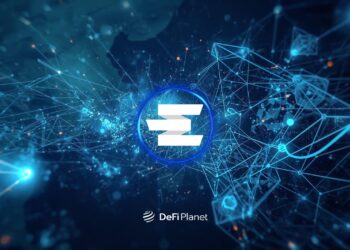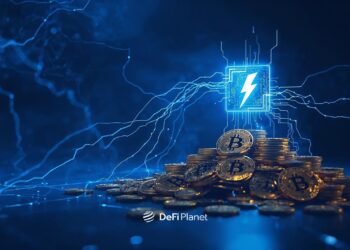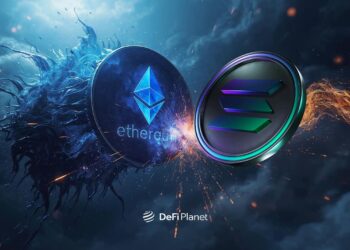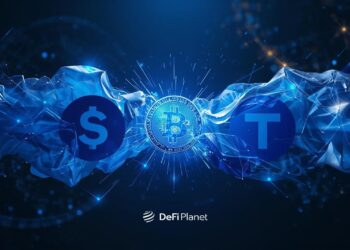Last updated on November 17th, 2022 at 02:07 pm
Decentralized Finance is redefining the concept of loans by allowing access to a variety of loans. Overcollateralized loans and flash loans are the two main types of DeFi loans. Overcollateralized loan providers anticipate that users will submit collateral worth more than the loan amount.
Users are not required to provide collateral in the case of flash loans. This article comprehensively analyzes the flash loan system and what to expect.
What is a Flash Loan?
Before the advent of flash loans, consumers relied on overcollateralized loans, which required them to deposit collateral. In the case of over-collateralized loans, consumers must submit collateral worth more than the loan amount.
Typically, the collateral value must be increased to avoid liquidation. Prices of cryptocurrencies may fall due to the volatility of the crypto market, and if the value of the collateral falls below a particular threshold, the collateral may be liquidated.
While enjoying the benefits of an overcollateralized loan, the user must constantly ensure that the value does not fall below the threshold and, if required, increase it.
The aforementioned are not required for flash loans. Because it is an unsecured, decentralized lending alternative, there is no collateral.
Because of the lack of security or collateral, the borrower is required to repay the loan in the same transaction.
Flash loans leverage smart contracts to ensure that the tenets are rigorously followed. If the borrower is unable to repay their loan in the same transaction, the smart contract immediately reverses the transaction.
Everything about a flash loan is completed in a single transaction. The borrowing process, including the use of borrowed cash for payment, is completed in a single transaction.
If the repayment requirement is not met, the loan is reversed using an Ethereum Improvement Proposal, EIP-140.
This functionality allows for the reversal of transactions, guaranteeing that the network returns to its previous state.
Because everything is done in a transaction, the entire procedure is far faster than an overcollateralized loan. Typically, smart contracts execute quick trades for the borrower using the loaned funds.
Assuming the borrowed funds did not generate a profit after trading. The smart contract automatically reverses the transaction. This means that the borrower is not required to pay anything, and the lender does not lose the loaned funds.
The Origin of Flash Loans
Marble, an open-source bank known for its unique financial features, invented flash loans.
Aave, an Ethereum-based platform, introduced the concept of flash loans into the DeFi space in 2020.
Flash loans have now grown very popular on Ethereum and other blockchain networks.
The Use Cases of Flash Loans
Traders employ flash loans for a variety of purposes, with the primary goal of profit.
Arbitrage trading
Flash loans are used by arbitrage traders to take advantage of liquidity and increase their profits. Typically, this entails exploiting price differences between exchanges. They purchase an asset at a low price on one exchange and immediately sell it for a higher price on another.
Assume a user detects a price difference between two exchanges for ETH. They may choose to obtain a flash loan via a DeFi protocol and utilize it to acquire ETH on a less expensive exchange. The Ether is then quickly sold on another exchange for a higher price. The user repays their loan with the money earned.
Lower fees
Because everything is done in a single transaction, the fees associated with flash loans are typically lower than those associated with traditional loans.
It is typical to see crypto enthusiasts use this approach to acquire or trade coins without incurring large gas fees.
Collateral Modification
Traders may take out a flash loan to replace collateral that they believe is not serving them well due to its low quality with one of greater quality.
This occurs when the traders discover that another DeFi protocol offers equivalent loans at lower interest rates.
Let’s assume the traders discover a better alternative. They begin by paying off the interest rate on the initial loan, which is usually higher. They then borrow the second loan at a lower interest rate.
What is a Flash Loan Attack?
Though flash loans are innovative, they are plagued with problems and risks, especially the risk of being attacked. Flash loan attacks have been extremely popular in recent years, and they are one of the methods by which decentralized financial protocols are attacked.
Flash loan attacks occur when hackers discover flaws or bugs in the smart contract code and exploit them. They obtain access and borrow without having to pay back using the loopholes. Some attackers may take advantage of the liquidity pool’s incorrect calculations.
This type of attack is usually swift and, sometimes, may occur multiple times before being detected by the protocols or the general public. Flash loan attacks are successful due to bugs discovered in the smart contract code.
A DeFi protocol may be built hastily without sufficient audits or tests, which would have revealed its vulnerabilities. A hacker analyzing the code or system may detect these flaws and exploit them. Flash loan attacks can happen because it is practically impossible for a development team or even third-party security audit platforms to detect every bug in a codebase.
In general, the prices of these pools are determined by the prices of various exchanges.
An arbitrage trader earns a profit by purchasing tokens at a low cost from one exchange and selling them at a higher price on another.
Price differences exist in the cryptocurrency market, and using them for arbitrage trading is permitted. A fraudster, on the other hand, may successfully carry out a flash loan attack by manipulating prices.
Popular Examples of Flash Loan Attacks?
History is replete with accounts of different flash loan attacks on decentralized finance protocols that resulted in the loss of millions of dollars.
Some of these cases will be examined below.
Alpha Homora Protocol
The Alpha Hamora protocol was subjected to several flash loan attacks in 2021, resulting in a $37 million loss.
It all started with the hacker borrowing sUSD from Iron Bank using the Alpha Homora decentralized application. They ended up borrowing twice as much each time. After the funds had been borrowed, they were transferred to the Iron Bank, allowing them to earn Yearn Synth sUSD (cySUSD).
The hacker then borrowed 1.8 million USD coins (USDC) from Aave and exchanged them for sUSD using Curve. It culminated with the use of the swapped tokens to pay for the flash loan. They did this a couple of times before being discovered.
Cream Finance
This DeFi protocol is no stranger to cyber-attacks.
It has faced a number of them, but the one that stands out the most cost them $130 million.
According to reports, “The funds appear to have been obtained via a flash loan in a highly complex transaction involving 68 different assets and costing more than 9 ETH in gas.
Of the $260 million lost, the attacker got around $130 million in various cryptocurrencies, $40.6 million of which may be in illiquid crETH, a staked ETH derivative that may be difficult for the attacker to sell.
The attacker is currently trying to “wash” the funds, primarily through Ren’s Bitcoin bridge.”
dYdX
In the case of the 2020 dYdX attack, the hacker borrowed funds through the flash loan option and then invested the funds in Compound and Fulcrum. The hacker converted their ETH to WBTC in Fulcrum.
Because Uniswap has a small liquidity pool, the value of WBTC rose significantly. They used a portion of the amount to request a WBTC flash loan on Compound. They promptly traded, making a lot of profit, as the value of the price on the Decentralized Exchange, UniSwap, rose.
In Conclusion,
- Flash loans are decentralized finance loans that are repaid in the same transaction.
- Users borrow, carry out transactions, and repay the loan all in one transaction.
- Users must pay interest on the flash loan.
- It is a non-collateralized loan, which means that consumers are not required to deposit any collateral.
- If the loan is not repaid, the transaction is reversed using an Ethereum Improvement Proposal, EIP-140.
- Flash loans are taken for different reasons, including fewer transaction fees, arbitrage services, and access to better interest rates.
- Though flash loans are innovative, they are vulnerable to attacks or manipulation.
- The origins of flash loans can be traced back to Marble Bank, an open-source bank.
- There are numerous DeFi protocols available on Ethereum and other blockchain networks that offer flash loans.
- To avoid scams, ensure you conduct due diligence before taking out a flash loan.
If you would like to read more articles like this, visit DeFi Planet and follow us on Twitter, LinkedIn, Facebook, and Instagram.





















